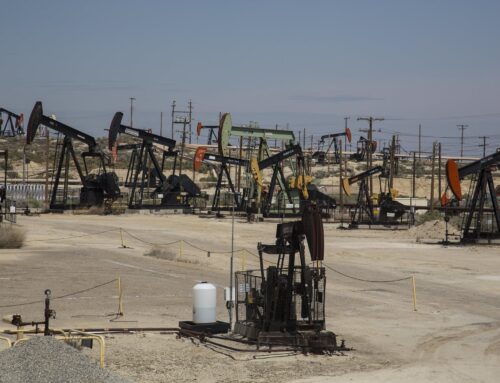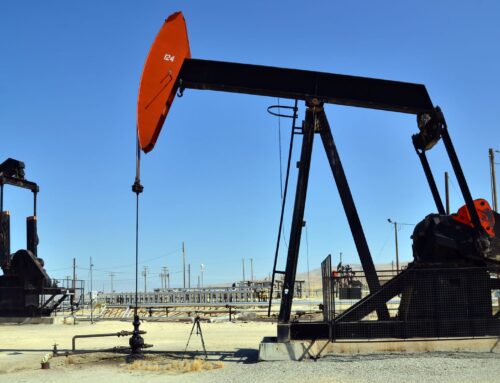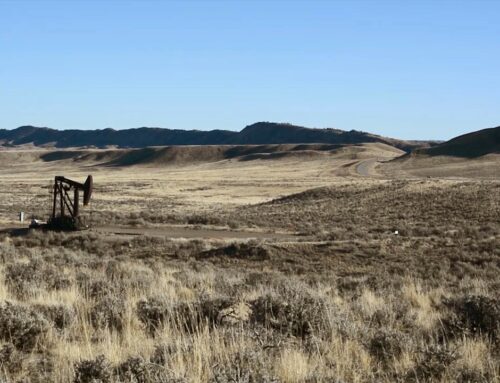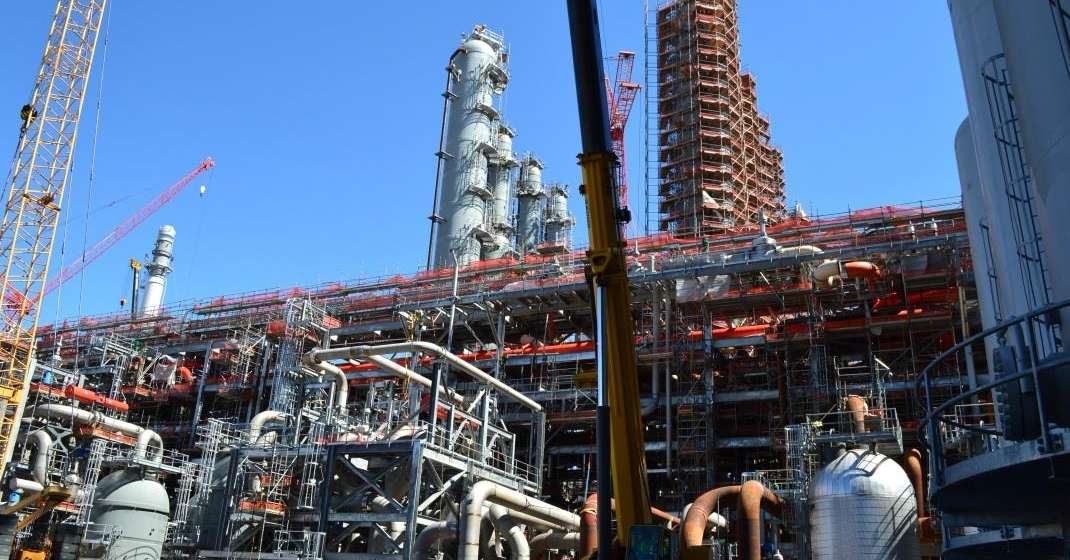Nearly two years ago, President Joe Biden signed the Inflation Reduction Act into law — breathing new life into a crucial U.S. incentive for carbon capture and storage.
Known as 45Q for its place in the tax code, the credit is considered the chief tool to advance a major climate priority of President Biden by providing funds for stored carbon dioxide. But despite the IRA’s boost of the incentive, the U.S. carbon capture industry remains limited by permitting headwinds and rising costs.
There is only one operating carbon capture project on a U.S. power plant today: the Petra Nova facility in Texas — the same plant that began operations in 2017 before later idling for three years.
Announcements of planned carbon capture projects and permit applications for carbon dioxide storage wells have jumped since the IRA was signed into law in August 2022, though the number of operating facilities in the U.S. hasn’t climbed at the same pace. There are now 16 commercial-scale CCS projects operating in the United States, up from 13 in October 2022. The projects are primarily on natural gas processing, ethanol and ammonia facilities — and miss many of the nation’s largest fossil fuel emitters.
Critics of carbon capture have rung alarm bells on 45Q, calling on the Treasury Department to increase oversight of the credit, saying it is promoted by the oil and gas sector as a way to further dependence on the industry. Backers of CCS say 45Q has been a success — but they say development takes time and that the credit could be modified further.
John Thompson, technology and markets director at the Clean Air Task Force, said it “takes several years to develop and build and operate” CCS projects.
That’s why “we have to rely on these sort of leading indicators” of filed permit applications, project announcements and final investment decisions to see a picture of what the future holds, rather than plants in operation, he said.
When projects that are under development and under construction are considered along with operational ones, the number of CCS facilities across the U.S. almost doubled — from 81 to 154 — from October 2022 to November 2023, according to the Global CCS Institute, a think tank supporting the technology. Projects in early and advanced development account for most of the uptick, while the number of facilities under construction rose from two in October 2022 to eight in November 2023.
Some projects have been linked directly to 45Q. Shortly after Biden signed the Inflation Reduction Act into law, Competitive Power Ventures, a power generation development company, announced plans to build a natural gas power plant in West Virginia with CCS, saying at the time that “the project was made possible by” the expanded credit, for example.
There has been a “significant boost” in investor interest in CCS in the United States following the IRA, said Jarad Daniels, CEO of the Global CCS Institute.
While there isn’t a one-size-fits-all solution to measure the success of 45Q, he said, “at the end of the day, the figure of merit is carbon emission avoided or carbon captured and durably stored, right, to prevent it from contributing to climate change.”
For a lot of project developers, the 45Q credit “literally makes or breaks the economics of their project,” said Geoff Tuff, a principal at Deloitte. Without it, he said, projects are “not going to move forward,” but with it, they will.
Daniels said projects in the United States will take longer to develop and become operational — compared to countries like China or Saudi Arabia — because of differences in governance and other factors.
There is a “time lag” in the United States because of the time it takes to navigate permitting, design and building a facility before it can go into full commercial operation, he said.
While the number of proposals has grown, the industry is far behind what experts say is needed to address climate change.
In an April report, DOE’s Office of Clean Energy Demonstrations said reaching net-zero greenhouse gas emissions economywide by 2050 would require the U.S. to increase carbon capture and storage capacity by 18 to 80 times current levels. Limiting carbon emissions is a priority for the Biden administration, which debuted a final EPA rule this spring that requires existing coal plants and future natural gas plants to address their CO2 emissions — with the “best system of emission reduction” based on CCS.
But CCS critics have expressed concerns that the credit opens the door to fraud and abuse.
In May, more than two dozen environmental and taxpayer groups, as well as some academics, pushed the IRS to increase oversight of the credit to “ensure our tax dollars aren’t wasted through abuse of the 45Q tax credit.” They said third parties should have to verify whether companies are storing the amount of carbon they claim.
That month, Steve Ellis, the president of Taxpayers for Common Sense — which signed onto the letter — told POLITICO’s E&E News that “the federal government’s reliance on industry self-reporting is concerning.”
David Schlissel, director of resource planning analysis at the Institute for Energy Economics and Financial Analysis, added that he hasn’t seen evidence of many final investment decisions on CCS proposals — the step where a company decides to formally move ahead with a project — since the IRA made changes to 45Q.
IEEFA is a think tank that advocates speeding up a transition to renewable energy.
45Q through the years
When Biden signed the climate law, carbon capture proponents cheered the 45Q modifications — including its higher credit values, an extension of the deadline to start project construction and lower capture thresholds — and characterized the changes as essential for greater CCS deployment.
The credit now provides up to $85 per metric ton when CO2 is geologically sequestered, and up to $60 per metric ton when it is stored via enhanced oil recovery (EOR).
The performance-based credit, named after a section of the tax code, has been around since 2008. The original version of 45Q provided only $20 per metric ton of carbon dioxide stored in geologic formations and $10 per metric ton for CO2 stored using EOR, where the greenhouse gas is used to help extract oil.
The credit was altered in 2018, raising the amount developers could ultimately receive to sequester CO2, but CCS backers sought further changes. That included a multiyear extension of the deadline for beginning project construction and a direct pay option for developers.
Along with raising the credit value of stored CO2 from energy facilities, the Inflation Reduction Act raised the amount available for developers for CO2 captured and stored from direct air capture (DAC) projects — where legacy CO2 is pulled out of the atmosphere.
Further, for those seeking to claim 45Q, the Inflation Reduction Act also moved the so-called commence construction deadline from the end of 2025 to the end of 2032.
The $85 per metric ton — and $180 per metric ton for DAC — “really put it across the threshold where, again, from an investor’s perspective, from a business case, some of this pencils out well as investable,” said Daniels of the Global CCS Institute. “And so, I think that was the major catalytic improvement we saw in 45Q.”
The Biden administration is also touting 45Q’s effects.
“Given the rapid expansion in [carbon capture, utilization and storage] project announcements and uptick in investment since passage, the impact is undeniable,” DOE said in a statement.
Last week, the IRS released new guidance for companies planning to claim 45Q. It contains details on what should be included in a life cycle analysis report to determine the amount of CO2 either captured from the atmosphere or “displaced from being emitted” into it.
The Carbon Capture Coalition, which supports increased deployment of carbon management technologies, said the guidance “provides more clarity and transparency” to the application process.
CO2 storage
Carbon capture observers said one of the clearest indicators of 45Q’s impact is that the number of permit applications submitted to EPA for geologic storage of CO2 has climbed significantly since the Inflation Reduction Act was signed.
The number of applications for Class VI wells — used to shoot CO2 into deep rock formations for long-term storage — now stands at more than 140 applications, according to an online tracker maintained by EPA.
That’s up about 34 percent over the last 12 months, the tracker shows, and comes after EPA granted primary enforcement authority, or “primacy,” over the well class to the state of Louisiana in December.
Some 84 percent of Class VI permit applications at EPA have been submitted in the last 24 months, said EPA spokesperson Remmington Belford, in an email last month.
Charles McConnell, executive director of the Center for Carbon Management in Energy at the University of Houston, said the increase in Class VI permit applications wouldn’t have happened without the changes to 45Q under the IRA.
Those changes “were not only necessary, but essential to create enthusiasm in the marketplace,” McConnell said. “If you hadn’t done it, this would have been dead in the water and we’d be having a conversation about how do we revive CCUS in this country.”
Low-carbon divisions at companies, project announcements, and Class VI permits are all signs that 45Q is working, McConnell added.
Daniels at the Global CCS Institute said there’s a “fair amount” of project development that has to happen before a company formally submits a Class VI permit application to EPA.
“The fact that we went from a handful to a lot right after the IRA, to me, is a pretty good data point that suggests how catalytic the IRA has been,” Daniels said.
EPA has faced criticism over how long it takes to review Class VI permit applications. In January, the agency issued two such permits — the first it had issued in nearly a decade.
Roughly a month later, however, a petition to review those permits was filed with EPA’s Environmental Appeals Board and briefs in the case continue to be filed.
Xan Fishman, senior director of the energy program at the Bipartisan Policy Center, a think tank, said it was encouraging that EPA decided to issue top enforcement authority over Class VI wells, or “primacy,” to the state of Louisiana.
A third of all Class VI applications to EPA were for projects in Louisiana, so letting the state “handle those gives [EPA] a lot more bandwidth to do the reviews” on applications for Class VI wells in other states, Fishman said.
He said there’s a desire to cut down on how long it takes the agency to process Class VI permit applications, adding that “what we want is a process that’s both efficient and safe.”
Belford, the EPA spokesperson, said the agency instituted a goal in late 2022 of issuing Class VI permitting decisions within 24 months of receiving a complete application.
“This time frame is dependent on several factors, including the complexity of the project and the quality and completeness of the submitted application,” Belford said.
Several environmental groups objected to EPA’s decision to grant primacy to Louisiana, claiming the state couldn’t handle the program. Some watchdog groups and politicians in Texas have opposed an effort by the state to also secure primacy.
Carbon capture challenges
Another challenge for carbon capture is the speed that federal agencies are issuing permits for projects, as well as increasing costs that can diminish the reach of $85 per metric ton.
McConnell said there’s a mismatch between the Biden administration’s goals on CCS — noting it’s a core part of the EPA power plant rule issued in April — and how fast it moves on permits.
“And so, we’ve got a real pickle here,” McConnell said. “We’re trying to advance an energy program to reduce emissions and at the same time looking at investments and cost creep that we haven’t seen in quite some time.”
Uncertainty around permits — whether it’s for pipelines, injection and installing a carbon capture unit at facilities and requirements that come with IRA funds — adds to the hurdles.
McConnell said requirements that the federal government has attached to IRA funding opportunities, including those like developing community engagement plans and environmental justice commitments, add to project development work.
Environmental justice includes the fair treatment and meaningful involvement of all people in the development, implementation and enforcement of environmental laws and policies.
The White House didn’t respond to a request for comment this month about the pace of CCS deployment in the United States or IRA funding requirements. But the administration has said that the Inflation Reduction Act should help spur the industry, which has not received as much support in the past as many say it has.
“There’s a significant misconception that there’s always been significant federal policy support for carbon capture and storage,” Brad Crabtree, DOE’s top official in the Office of Fossil Energy and Carbon Management, told E&E News in a March 2023 interview.
In October 2022, EPA submitted a report to Congress on recommendations to improve Class VI permitting, agreeing in the assessment that “the permitting process could be streamlined, particularly when compared to the process used to permit the very first Class VI wells.”
Belford said “EPA is committed to thoroughly reviewing Class VI permit applications to ensure that the environment, drinking water supplies and public health are protected.”
Last year, EPA’s Office of Inspector General announced plans to evaluate the agency’s Class VI well program to “determine whether the EPA has used available resources” to improve permitting of the well class.
More changes to 45Q?
Additional policy mechanisms will be needed to help drive greater deployment of CCS, said Jessie Stolark, executive director of the Carbon Capture Coalition, which includes more than 100 companies, unions and environmental policy organizations that support deployment of carbon management technologies. Those could range from federal efforts to “buy clean,” or low-carbon materials, to states looking at electricity standards, she said.
“45Q cannot be the end-all be-all for deploying the technology,” said Stolark, adding that the credit is the most bankable tool that a project developer can take to an investor right now.
Projects moving ahead are those with more concentrated streams of CO2 — like with ethanol facilities — or those that have to transport CO2 a shorter distance, Stolark said. The capture process typically is cheaper with concentrated streams of CO2.
That raises the question of whether the value of $85 per metric ton — for storage in geologic formations — is enough for sectors like steel, cement and the power sector, where costs are higher given the diluteness of the CO2.
“How well does the current value of $85 work for some of these hard-to-abate sources?’” Thompson said.
He said that the current value works well for industries like hydrogen and ethanol, but “probably we are going to need to do something more — maybe sector specific — on cement, sector specific on steel, maybe it’s fixing some of the inflation adjustment on 45Q.”
At some point, Congress will need to extend the commence construction deadline and increase the value of 45Q, McConnell said.
He said he supports more states getting primacy over Class VI wells, rather than hiring more people to process those applications at EPA. About a dozen states are well-suited geologically to do carbon capture, he said.
Stolark at the Carbon Capture Coalition said 45Q isn’t indexed for inflation until 2027, “and so, we’re already seeing erosion of the value of the credit.”
The issue isn’t unique to carbon management technologies, she said, but given the inflationary environment when the Inflation Reduction Act passed in 2022, it’s important to note how much project costs have gone up over time.
The coalition is advocating for indexing the credit for inflation and using 2022 as the base year.
There’s also a push for the CCU Parity Act, which was introduced in Congress last year and would boost levels for carbon reuse in low- and zero-carbon products and making those equal to levels for geologic storage, Stolark said.
“I think we’ll look at the end of the decade at what the current state of affairs is, and say, ‘Should we extend 45Q? And, if so, at what levels?’” Fishman said.
- Image from Canva Pro and E&E logo property of E&E News










